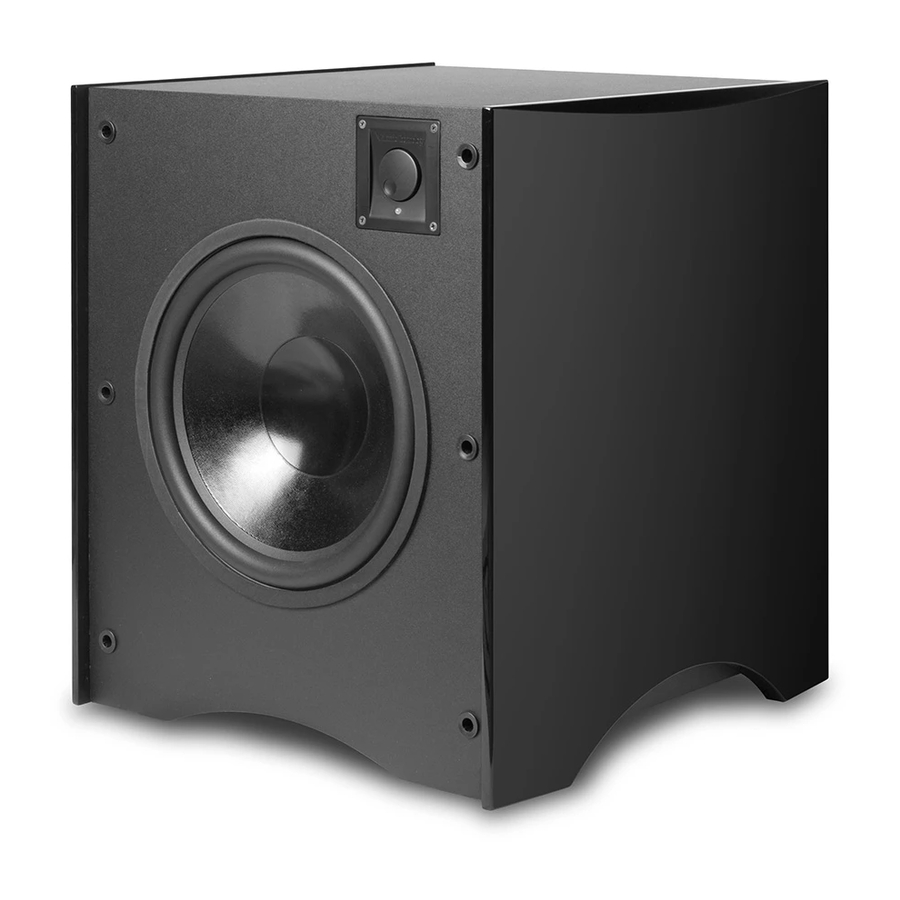Atlantic Technology 102 SB Manuel d'instruction - Page 9
Parcourez en ligne ou téléchargez le pdf Manuel d'instruction pour {nom_de_la_catégorie} Atlantic Technology 102 SB. Atlantic Technology 102 SB 12 pages. Sb-series box subwoofers
Également pour Atlantic Technology 102 SB : Fiche d'information sur le produit (2 pages)

Instruction Manual
Placement and Operation
Generally speaking,the best location for your new subwoofer is the front
of the room,close to a corner (Figure 5).Every room has its own unique
sound characteristics, and flexibility in the exact placement of the sub-
woofer is always desirable. The closer the subwoofer is placed to a wall
and especially a corner,the more and deeper the bass response you will
hear.Because of an acoustic phenomenon known as "room gain," a well-
designed wubwoofer playing in an acoustically-favorable room may well
deliver low bass deeper than its rated response.However,in some rooms,
corner placement can produce a "one note" boomy effect. Under such
circumstances the subwoofer may work better away from the corner.
Experiment to find the best position in your room.
HELPFUL HINT: A particularly useful experiment is to place the
subwoofer right at the prime listening position (move your couch
or chair out of the way and put the sub in its place). Then play
something with good bass content (preferably music), and walk
around the room, listening to the subwoofer's response. When
you locate an area that has an ample amount of well defined bass,
you've found a good potential place to locate the sub.
Figure 5
Typical arrangement for a single subwoofer in a home theater.
1. Start here
System Set Up
When setting up a complete home theater we strongly recommend that
you use a Sound Pressure Level meter. Radio Shack® has a good one
that is very affordably priced (approximately $40-50).To use this meter,
turn on your system, put the Processor/Receiver in the Test Mode and
set its main volume control to 0dB.Sit in the prime listening position,set
the SPL meter to the 70dB scale, Slow Response, and C Weighting. Now,
holding the meter pointed up and in front of you,let the system cycle its
test tone from speaker to speaker and set every speaker to 75dB using
the individual level settings in the Processor/Receiver.As tempting as it
may be to set the subwoofer and/or surround speakers higher than 75dB,
listen again after calibration and see if you can acclimate to these levels.
Try watching several different movies and keep in mind that the goal is to
have a system that sounds like you're actually"in the movie. " When using
the latest discrete digital electronics which include internal level controls
for all channels,we recommend setting the 422 SB's front mounted Level
Control to its Preset position and using the Processor/Receiver's built-in
subwoofer level control.
On the 212 SB you can use the level control on the rear panel to make
this adjustment. If you decide not to use an SPL meter try to set all the
speaker levels the same using the Test Tones.Of course,this will be much
more difficult without the meter,especially for the subwoofer.
Figure 6
(422 SB only) Front Panel Variable Level Control located behind the removable grille
Subwoofer Tuning Without an SPL Meter
or Test Tones
Start your listening with the subwoofer Crossover control set at around
100Hz or in the Bypass position if you're using a THX Certified proces-
2. Move to
corner for
sor or unit with a built-in crossover.Set the phase switch to normal,and
more bass
the front panel variable level control (Figure 6) to the Preset position.
Play some music that you know has good bass content, and turn the
level control up until you just start to hear the subwoofer working.Now,
from your normal listening position, determine whether the subwoofer
is playing loudly enough and filling in the bass frequencies of the music
evenly. If adjustment is necessary, start by changing the setting in the
3. Move away
processor or with the level control if your processor lacks a subwoofer
from wall for
less bass
level adjustment.
If the bass seems too ponderous, boomy, or heavy, no matter how you
set the level, try moving the subwoofer away from the wall/corner. If
the bass seems too thin, try moving the subwoofer closer to the wall/
corner.Small differences in positioning can make big differences in bass
response.When you find a position that seems to work well, try switch-
ing the phase switch between its two settings,listening particularly to the
transition from the subwoofer to the satellites.
How Much is Enough?
Sometimes people prefer more bass impact for movies.Using the movie
setting for music can result in overpowering and unnatural bass repro-
duction. You may wish to determine both a video level and an audio
level if you find yourself falling into this camp. Remember however, the
most common error people make when setting up their system is to play
the subwoofer (and surrounds) too loudly.Of course,the Home Theater
Police will not arrest you for this act. But should you desire the most
accurate overall reproduction,a well balanced sound from bass to high-
est treble is the best way to get it.Have fun.Experiment.Enjoy.
Placement and Operation
Recess and indicator for
level adjustment
Fixed Position
Indicator LED
9
